Marketing Plan Assignment : National Portrait Art Gallery
VerifiedAdded on 2021/01/02
|9
|2461
|77
AI Summary
Contribute Materials
Your contribution can guide someone’s learning journey. Share your
documents today.
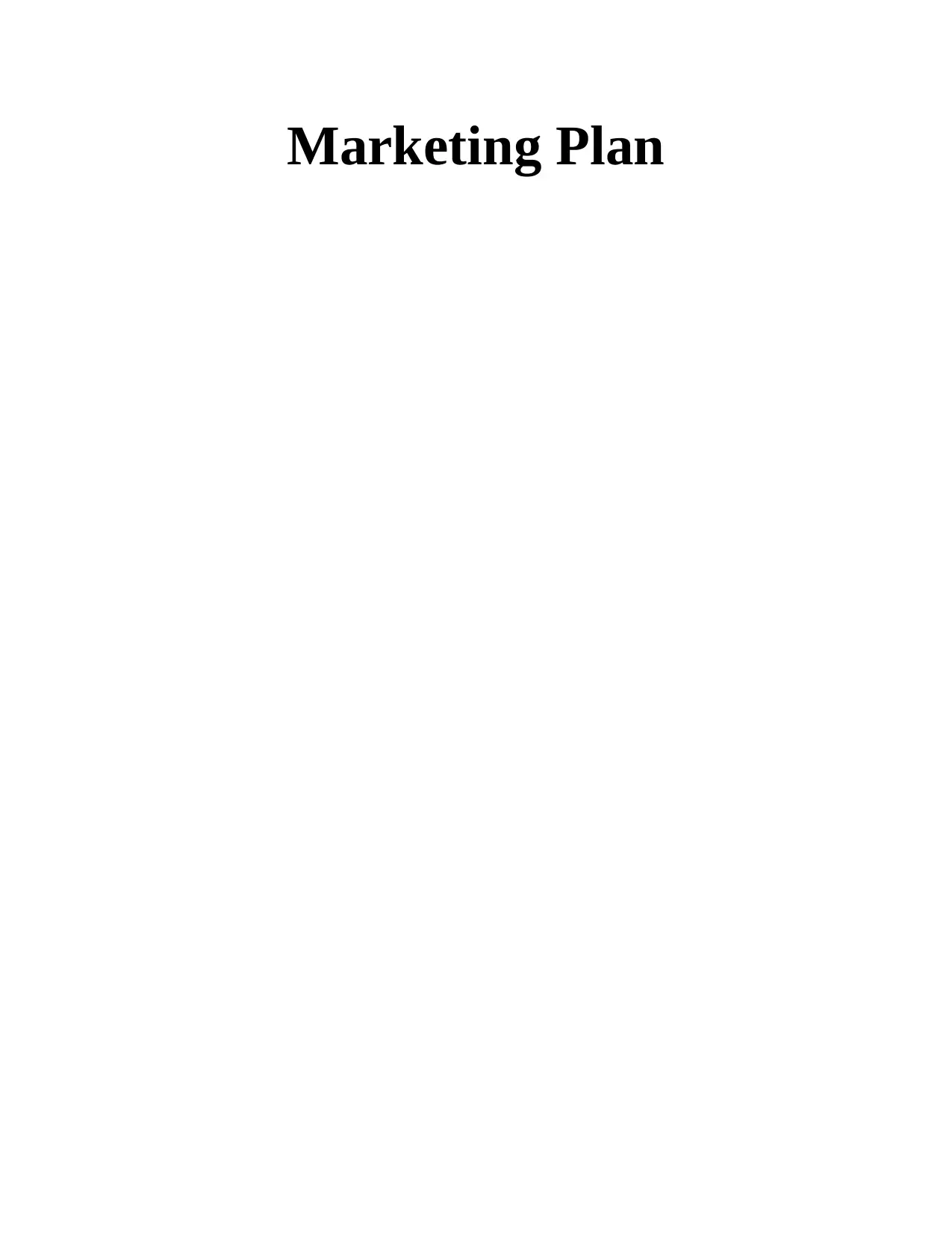
Marketing Plan
Secure Best Marks with AI Grader
Need help grading? Try our AI Grader for instant feedback on your assignments.
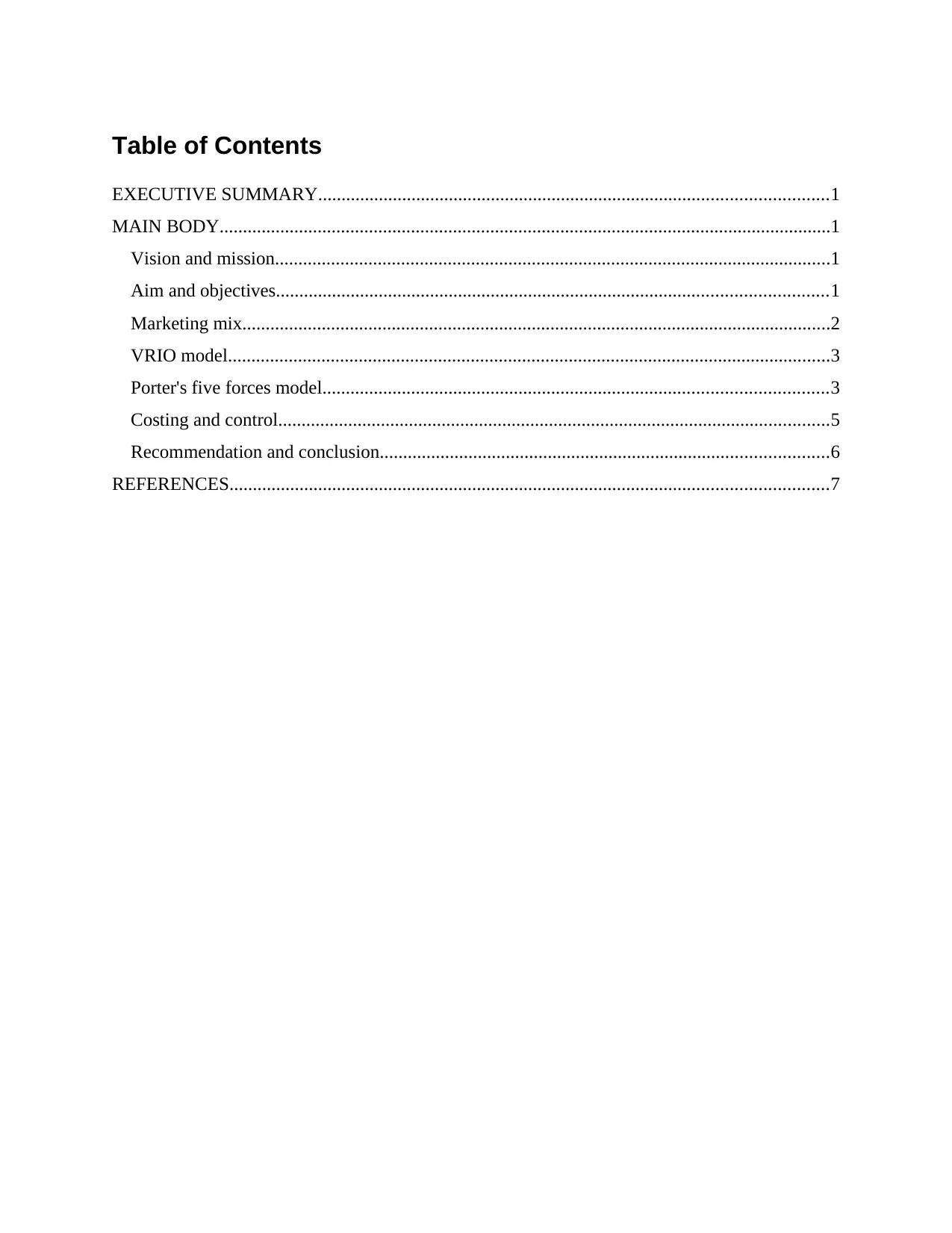
Table of Contents
EXECUTIVE SUMMARY.............................................................................................................1
MAIN BODY...................................................................................................................................1
Vision and mission.......................................................................................................................1
Aim and objectives......................................................................................................................1
Marketing mix..............................................................................................................................2
VRIO model.................................................................................................................................3
Porter's five forces model............................................................................................................3
Costing and control......................................................................................................................5
Recommendation and conclusion................................................................................................6
REFERENCES................................................................................................................................7
EXECUTIVE SUMMARY.............................................................................................................1
MAIN BODY...................................................................................................................................1
Vision and mission.......................................................................................................................1
Aim and objectives......................................................................................................................1
Marketing mix..............................................................................................................................2
VRIO model.................................................................................................................................3
Porter's five forces model............................................................................................................3
Costing and control......................................................................................................................5
Recommendation and conclusion................................................................................................6
REFERENCES................................................................................................................................7
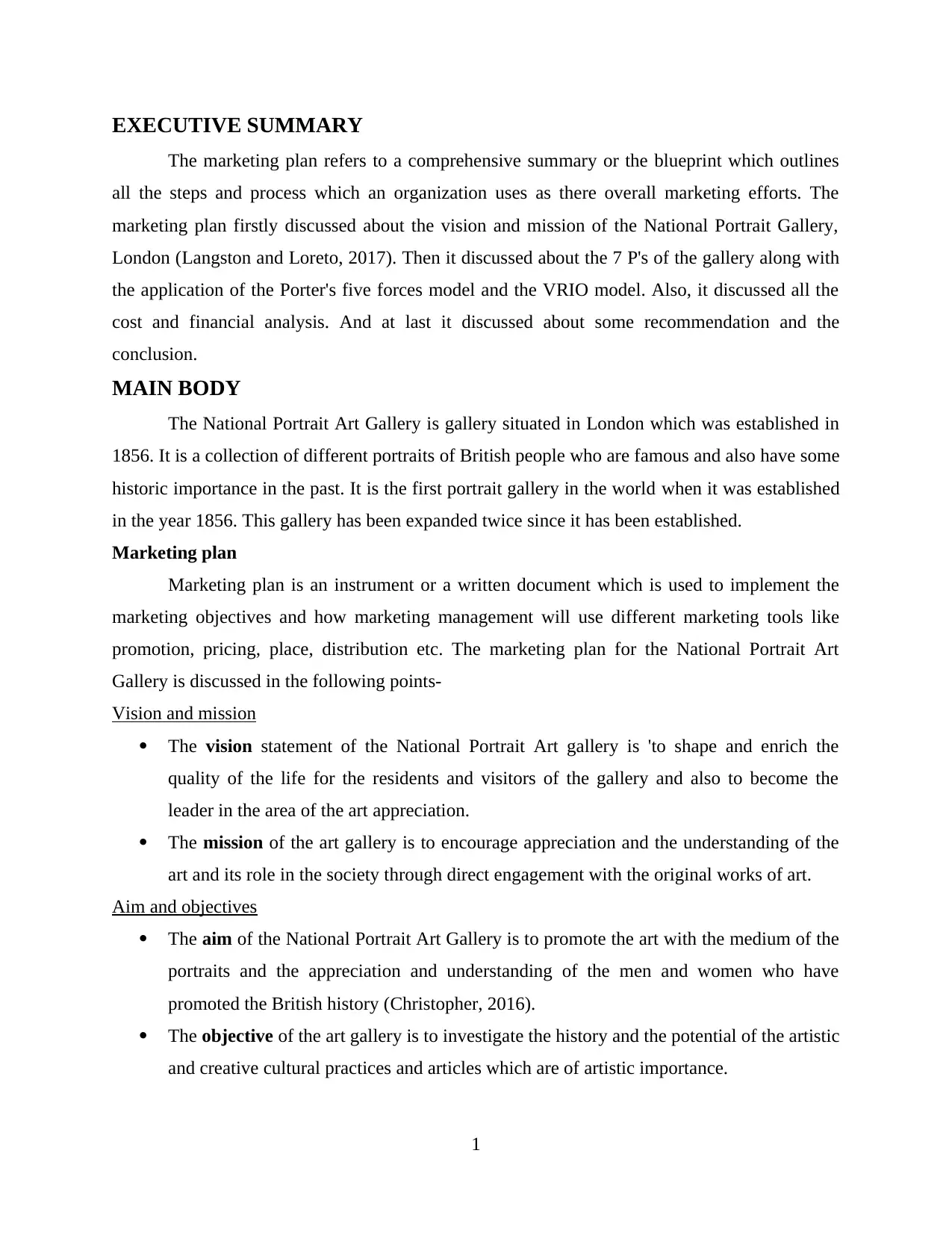
EXECUTIVE SUMMARY
The marketing plan refers to a comprehensive summary or the blueprint which outlines
all the steps and process which an organization uses as there overall marketing efforts. The
marketing plan firstly discussed about the vision and mission of the National Portrait Gallery,
London (Langston and Loreto, 2017). Then it discussed about the 7 P's of the gallery along with
the application of the Porter's five forces model and the VRIO model. Also, it discussed all the
cost and financial analysis. And at last it discussed about some recommendation and the
conclusion.
MAIN BODY
The National Portrait Art Gallery is gallery situated in London which was established in
1856. It is a collection of different portraits of British people who are famous and also have some
historic importance in the past. It is the first portrait gallery in the world when it was established
in the year 1856. This gallery has been expanded twice since it has been established.
Marketing plan
Marketing plan is an instrument or a written document which is used to implement the
marketing objectives and how marketing management will use different marketing tools like
promotion, pricing, place, distribution etc. The marketing plan for the National Portrait Art
Gallery is discussed in the following points-
Vision and mission
The vision statement of the National Portrait Art gallery is 'to shape and enrich the
quality of the life for the residents and visitors of the gallery and also to become the
leader in the area of the art appreciation.
The mission of the art gallery is to encourage appreciation and the understanding of the
art and its role in the society through direct engagement with the original works of art.
Aim and objectives
The aim of the National Portrait Art Gallery is to promote the art with the medium of the
portraits and the appreciation and understanding of the men and women who have
promoted the British history (Christopher, 2016).
The objective of the art gallery is to investigate the history and the potential of the artistic
and creative cultural practices and articles which are of artistic importance.
1
The marketing plan refers to a comprehensive summary or the blueprint which outlines
all the steps and process which an organization uses as there overall marketing efforts. The
marketing plan firstly discussed about the vision and mission of the National Portrait Gallery,
London (Langston and Loreto, 2017). Then it discussed about the 7 P's of the gallery along with
the application of the Porter's five forces model and the VRIO model. Also, it discussed all the
cost and financial analysis. And at last it discussed about some recommendation and the
conclusion.
MAIN BODY
The National Portrait Art Gallery is gallery situated in London which was established in
1856. It is a collection of different portraits of British people who are famous and also have some
historic importance in the past. It is the first portrait gallery in the world when it was established
in the year 1856. This gallery has been expanded twice since it has been established.
Marketing plan
Marketing plan is an instrument or a written document which is used to implement the
marketing objectives and how marketing management will use different marketing tools like
promotion, pricing, place, distribution etc. The marketing plan for the National Portrait Art
Gallery is discussed in the following points-
Vision and mission
The vision statement of the National Portrait Art gallery is 'to shape and enrich the
quality of the life for the residents and visitors of the gallery and also to become the
leader in the area of the art appreciation.
The mission of the art gallery is to encourage appreciation and the understanding of the
art and its role in the society through direct engagement with the original works of art.
Aim and objectives
The aim of the National Portrait Art Gallery is to promote the art with the medium of the
portraits and the appreciation and understanding of the men and women who have
promoted the British history (Christopher, 2016).
The objective of the art gallery is to investigate the history and the potential of the artistic
and creative cultural practices and articles which are of artistic importance.
1
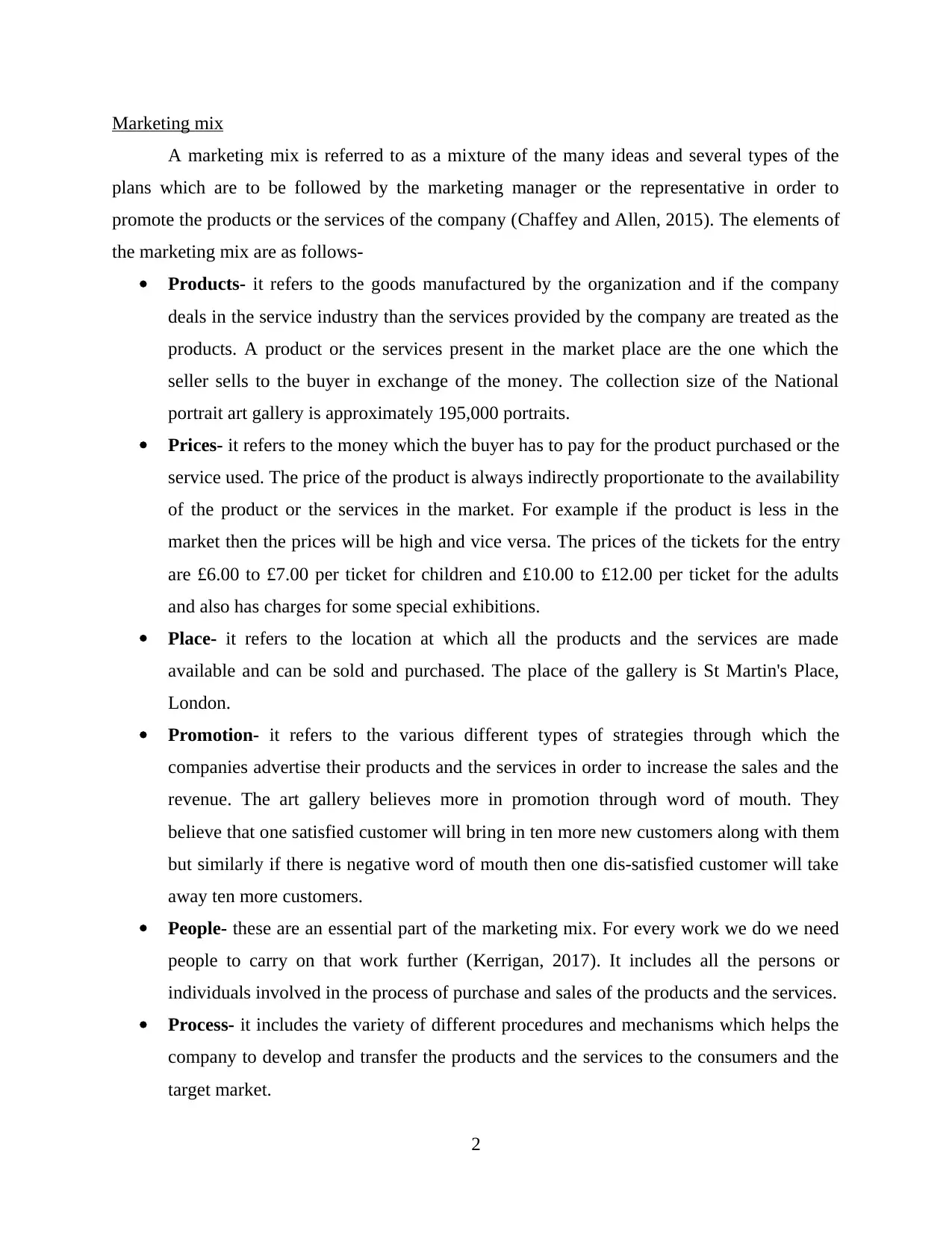
Marketing mix
A marketing mix is referred to as a mixture of the many ideas and several types of the
plans which are to be followed by the marketing manager or the representative in order to
promote the products or the services of the company (Chaffey and Allen, 2015). The elements of
the marketing mix are as follows-
Products- it refers to the goods manufactured by the organization and if the company
deals in the service industry than the services provided by the company are treated as the
products. A product or the services present in the market place are the one which the
seller sells to the buyer in exchange of the money. The collection size of the National
portrait art gallery is approximately 195,000 portraits.
Prices- it refers to the money which the buyer has to pay for the product purchased or the
service used. The price of the product is always indirectly proportionate to the availability
of the product or the services in the market. For example if the product is less in the
market then the prices will be high and vice versa. The prices of the tickets for the entry
are £6.00 to £7.00 per ticket for children and £10.00 to £12.00 per ticket for the adults
and also has charges for some special exhibitions.
Place- it refers to the location at which all the products and the services are made
available and can be sold and purchased. The place of the gallery is St Martin's Place,
London.
Promotion- it refers to the various different types of strategies through which the
companies advertise their products and the services in order to increase the sales and the
revenue. The art gallery believes more in promotion through word of mouth. They
believe that one satisfied customer will bring in ten more new customers along with them
but similarly if there is negative word of mouth then one dis-satisfied customer will take
away ten more customers.
People- these are an essential part of the marketing mix. For every work we do we need
people to carry on that work further (Kerrigan, 2017). It includes all the persons or
individuals involved in the process of purchase and sales of the products and the services.
Process- it includes the variety of different procedures and mechanisms which helps the
company to develop and transfer the products and the services to the consumers and the
target market.
2
A marketing mix is referred to as a mixture of the many ideas and several types of the
plans which are to be followed by the marketing manager or the representative in order to
promote the products or the services of the company (Chaffey and Allen, 2015). The elements of
the marketing mix are as follows-
Products- it refers to the goods manufactured by the organization and if the company
deals in the service industry than the services provided by the company are treated as the
products. A product or the services present in the market place are the one which the
seller sells to the buyer in exchange of the money. The collection size of the National
portrait art gallery is approximately 195,000 portraits.
Prices- it refers to the money which the buyer has to pay for the product purchased or the
service used. The price of the product is always indirectly proportionate to the availability
of the product or the services in the market. For example if the product is less in the
market then the prices will be high and vice versa. The prices of the tickets for the entry
are £6.00 to £7.00 per ticket for children and £10.00 to £12.00 per ticket for the adults
and also has charges for some special exhibitions.
Place- it refers to the location at which all the products and the services are made
available and can be sold and purchased. The place of the gallery is St Martin's Place,
London.
Promotion- it refers to the various different types of strategies through which the
companies advertise their products and the services in order to increase the sales and the
revenue. The art gallery believes more in promotion through word of mouth. They
believe that one satisfied customer will bring in ten more new customers along with them
but similarly if there is negative word of mouth then one dis-satisfied customer will take
away ten more customers.
People- these are an essential part of the marketing mix. For every work we do we need
people to carry on that work further (Kerrigan, 2017). It includes all the persons or
individuals involved in the process of purchase and sales of the products and the services.
Process- it includes the variety of different procedures and mechanisms which helps the
company to develop and transfer the products and the services to the consumers and the
target market.
2
Secure Best Marks with AI Grader
Need help grading? Try our AI Grader for instant feedback on your assignments.
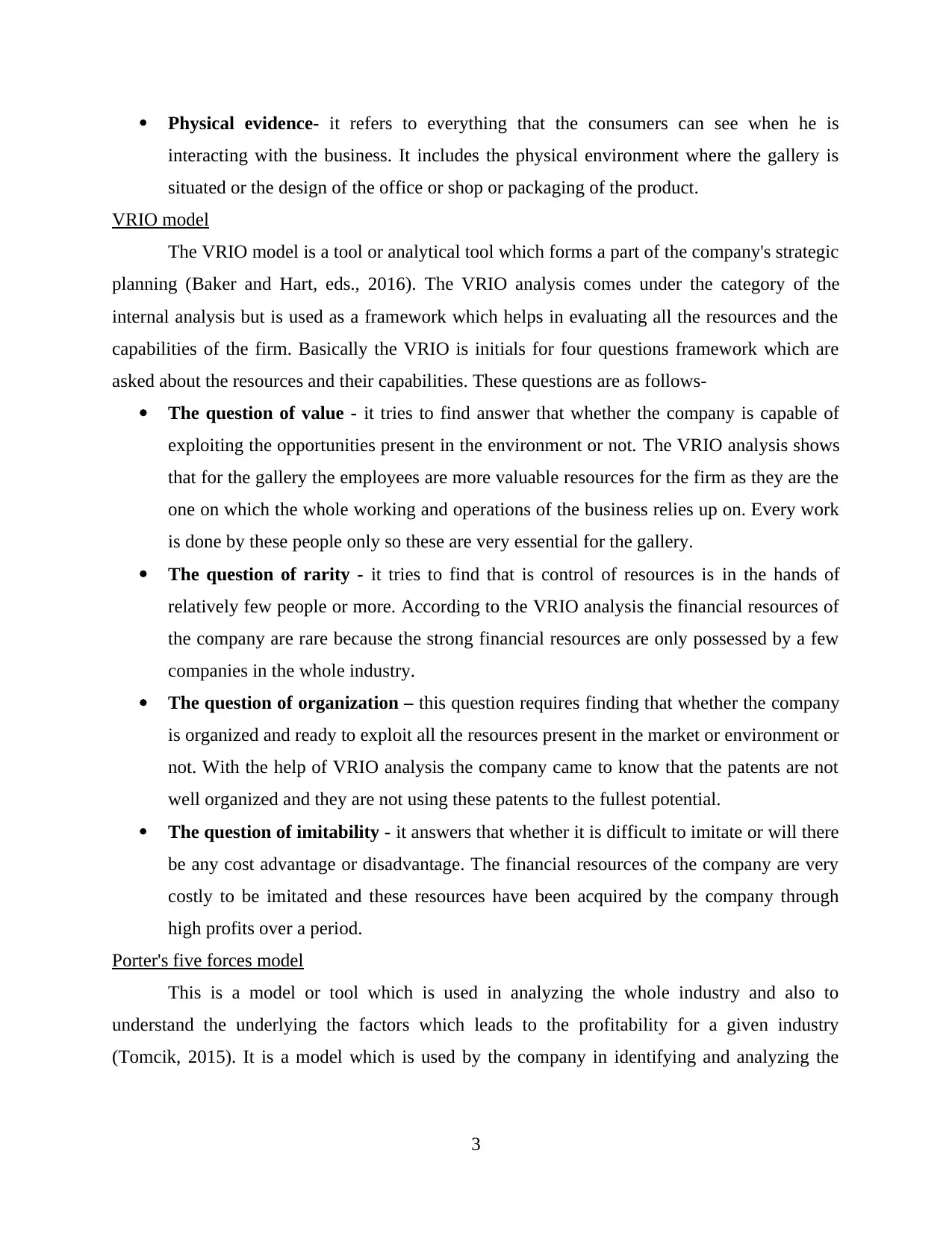
Physical evidence- it refers to everything that the consumers can see when he is
interacting with the business. It includes the physical environment where the gallery is
situated or the design of the office or shop or packaging of the product.
VRIO model
The VRIO model is a tool or analytical tool which forms a part of the company's strategic
planning (Baker and Hart, eds., 2016). The VRIO analysis comes under the category of the
internal analysis but is used as a framework which helps in evaluating all the resources and the
capabilities of the firm. Basically the VRIO is initials for four questions framework which are
asked about the resources and their capabilities. These questions are as follows-
The question of value - it tries to find answer that whether the company is capable of
exploiting the opportunities present in the environment or not. The VRIO analysis shows
that for the gallery the employees are more valuable resources for the firm as they are the
one on which the whole working and operations of the business relies up on. Every work
is done by these people only so these are very essential for the gallery.
The question of rarity - it tries to find that is control of resources is in the hands of
relatively few people or more. According to the VRIO analysis the financial resources of
the company are rare because the strong financial resources are only possessed by a few
companies in the whole industry.
The question of organization – this question requires finding that whether the company
is organized and ready to exploit all the resources present in the market or environment or
not. With the help of VRIO analysis the company came to know that the patents are not
well organized and they are not using these patents to the fullest potential.
The question of imitability - it answers that whether it is difficult to imitate or will there
be any cost advantage or disadvantage. The financial resources of the company are very
costly to be imitated and these resources have been acquired by the company through
high profits over a period.
Porter's five forces model
This is a model or tool which is used in analyzing the whole industry and also to
understand the underlying the factors which leads to the profitability for a given industry
(Tomcik, 2015). It is a model which is used by the company in identifying and analyzing the
3
interacting with the business. It includes the physical environment where the gallery is
situated or the design of the office or shop or packaging of the product.
VRIO model
The VRIO model is a tool or analytical tool which forms a part of the company's strategic
planning (Baker and Hart, eds., 2016). The VRIO analysis comes under the category of the
internal analysis but is used as a framework which helps in evaluating all the resources and the
capabilities of the firm. Basically the VRIO is initials for four questions framework which are
asked about the resources and their capabilities. These questions are as follows-
The question of value - it tries to find answer that whether the company is capable of
exploiting the opportunities present in the environment or not. The VRIO analysis shows
that for the gallery the employees are more valuable resources for the firm as they are the
one on which the whole working and operations of the business relies up on. Every work
is done by these people only so these are very essential for the gallery.
The question of rarity - it tries to find that is control of resources is in the hands of
relatively few people or more. According to the VRIO analysis the financial resources of
the company are rare because the strong financial resources are only possessed by a few
companies in the whole industry.
The question of organization – this question requires finding that whether the company
is organized and ready to exploit all the resources present in the market or environment or
not. With the help of VRIO analysis the company came to know that the patents are not
well organized and they are not using these patents to the fullest potential.
The question of imitability - it answers that whether it is difficult to imitate or will there
be any cost advantage or disadvantage. The financial resources of the company are very
costly to be imitated and these resources have been acquired by the company through
high profits over a period.
Porter's five forces model
This is a model or tool which is used in analyzing the whole industry and also to
understand the underlying the factors which leads to the profitability for a given industry
(Tomcik, 2015). It is a model which is used by the company in identifying and analyzing the
3
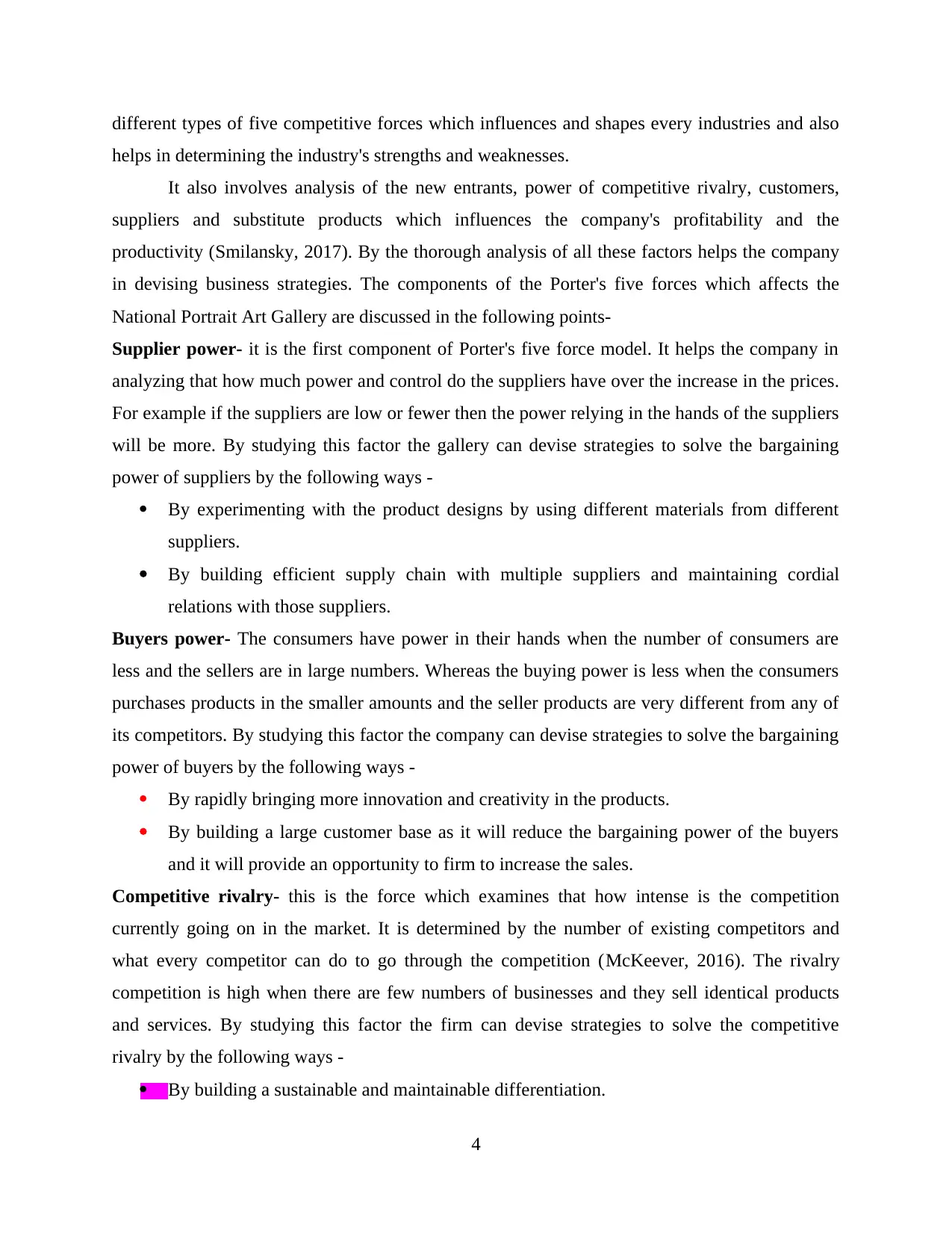
different types of five competitive forces which influences and shapes every industries and also
helps in determining the industry's strengths and weaknesses.
It also involves analysis of the new entrants, power of competitive rivalry, customers,
suppliers and substitute products which influences the company's profitability and the
productivity (Smilansky, 2017). By the thorough analysis of all these factors helps the company
in devising business strategies. The components of the Porter's five forces which affects the
National Portrait Art Gallery are discussed in the following points-
Supplier power- it is the first component of Porter's five force model. It helps the company in
analyzing that how much power and control do the suppliers have over the increase in the prices.
For example if the suppliers are low or fewer then the power relying in the hands of the suppliers
will be more. By studying this factor the gallery can devise strategies to solve the bargaining
power of suppliers by the following ways -
By experimenting with the product designs by using different materials from different
suppliers.
By building efficient supply chain with multiple suppliers and maintaining cordial
relations with those suppliers.
Buyers power- The consumers have power in their hands when the number of consumers are
less and the sellers are in large numbers. Whereas the buying power is less when the consumers
purchases products in the smaller amounts and the seller products are very different from any of
its competitors. By studying this factor the company can devise strategies to solve the bargaining
power of buyers by the following ways -
By rapidly bringing more innovation and creativity in the products.
By building a large customer base as it will reduce the bargaining power of the buyers
and it will provide an opportunity to firm to increase the sales.
Competitive rivalry- this is the force which examines that how intense is the competition
currently going on in the market. It is determined by the number of existing competitors and
what every competitor can do to go through the competition (McKeever, 2016). The rivalry
competition is high when there are few numbers of businesses and they sell identical products
and services. By studying this factor the firm can devise strategies to solve the competitive
rivalry by the following ways -
By building a sustainable and maintainable differentiation.
4
helps in determining the industry's strengths and weaknesses.
It also involves analysis of the new entrants, power of competitive rivalry, customers,
suppliers and substitute products which influences the company's profitability and the
productivity (Smilansky, 2017). By the thorough analysis of all these factors helps the company
in devising business strategies. The components of the Porter's five forces which affects the
National Portrait Art Gallery are discussed in the following points-
Supplier power- it is the first component of Porter's five force model. It helps the company in
analyzing that how much power and control do the suppliers have over the increase in the prices.
For example if the suppliers are low or fewer then the power relying in the hands of the suppliers
will be more. By studying this factor the gallery can devise strategies to solve the bargaining
power of suppliers by the following ways -
By experimenting with the product designs by using different materials from different
suppliers.
By building efficient supply chain with multiple suppliers and maintaining cordial
relations with those suppliers.
Buyers power- The consumers have power in their hands when the number of consumers are
less and the sellers are in large numbers. Whereas the buying power is less when the consumers
purchases products in the smaller amounts and the seller products are very different from any of
its competitors. By studying this factor the company can devise strategies to solve the bargaining
power of buyers by the following ways -
By rapidly bringing more innovation and creativity in the products.
By building a large customer base as it will reduce the bargaining power of the buyers
and it will provide an opportunity to firm to increase the sales.
Competitive rivalry- this is the force which examines that how intense is the competition
currently going on in the market. It is determined by the number of existing competitors and
what every competitor can do to go through the competition (McKeever, 2016). The rivalry
competition is high when there are few numbers of businesses and they sell identical products
and services. By studying this factor the firm can devise strategies to solve the competitive
rivalry by the following ways -
By building a sustainable and maintainable differentiation.
4
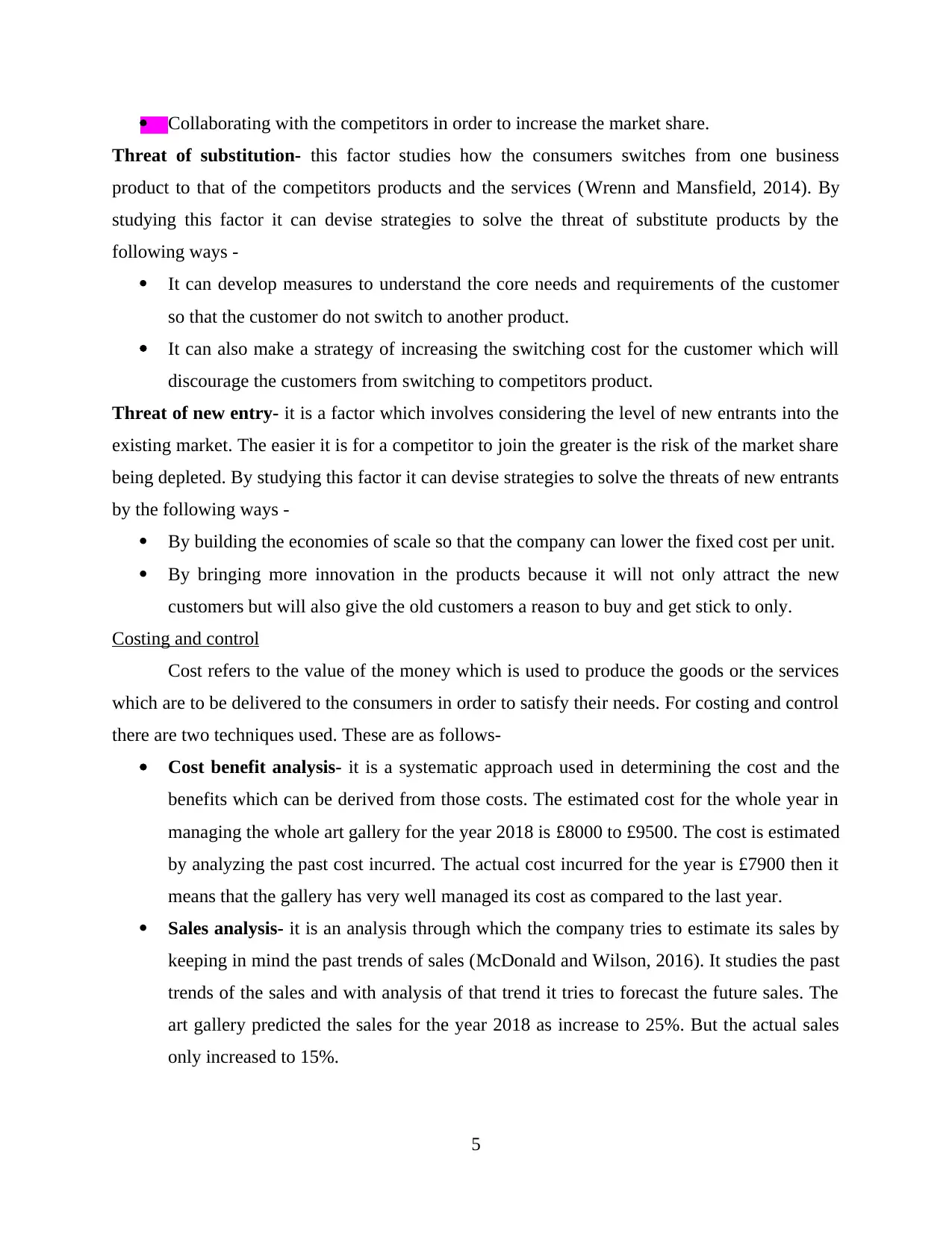
Collaborating with the competitors in order to increase the market share.
Threat of substitution- this factor studies how the consumers switches from one business
product to that of the competitors products and the services (Wrenn and Mansfield, 2014). By
studying this factor it can devise strategies to solve the threat of substitute products by the
following ways -
It can develop measures to understand the core needs and requirements of the customer
so that the customer do not switch to another product.
It can also make a strategy of increasing the switching cost for the customer which will
discourage the customers from switching to competitors product.
Threat of new entry- it is a factor which involves considering the level of new entrants into the
existing market. The easier it is for a competitor to join the greater is the risk of the market share
being depleted. By studying this factor it can devise strategies to solve the threats of new entrants
by the following ways -
By building the economies of scale so that the company can lower the fixed cost per unit.
By bringing more innovation in the products because it will not only attract the new
customers but will also give the old customers a reason to buy and get stick to only.
Costing and control
Cost refers to the value of the money which is used to produce the goods or the services
which are to be delivered to the consumers in order to satisfy their needs. For costing and control
there are two techniques used. These are as follows-
Cost benefit analysis- it is a systematic approach used in determining the cost and the
benefits which can be derived from those costs. The estimated cost for the whole year in
managing the whole art gallery for the year 2018 is £8000 to £9500. The cost is estimated
by analyzing the past cost incurred. The actual cost incurred for the year is £7900 then it
means that the gallery has very well managed its cost as compared to the last year.
Sales analysis- it is an analysis through which the company tries to estimate its sales by
keeping in mind the past trends of sales (McDonald and Wilson, 2016). It studies the past
trends of the sales and with analysis of that trend it tries to forecast the future sales. The
art gallery predicted the sales for the year 2018 as increase to 25%. But the actual sales
only increased to 15%.
5
Threat of substitution- this factor studies how the consumers switches from one business
product to that of the competitors products and the services (Wrenn and Mansfield, 2014). By
studying this factor it can devise strategies to solve the threat of substitute products by the
following ways -
It can develop measures to understand the core needs and requirements of the customer
so that the customer do not switch to another product.
It can also make a strategy of increasing the switching cost for the customer which will
discourage the customers from switching to competitors product.
Threat of new entry- it is a factor which involves considering the level of new entrants into the
existing market. The easier it is for a competitor to join the greater is the risk of the market share
being depleted. By studying this factor it can devise strategies to solve the threats of new entrants
by the following ways -
By building the economies of scale so that the company can lower the fixed cost per unit.
By bringing more innovation in the products because it will not only attract the new
customers but will also give the old customers a reason to buy and get stick to only.
Costing and control
Cost refers to the value of the money which is used to produce the goods or the services
which are to be delivered to the consumers in order to satisfy their needs. For costing and control
there are two techniques used. These are as follows-
Cost benefit analysis- it is a systematic approach used in determining the cost and the
benefits which can be derived from those costs. The estimated cost for the whole year in
managing the whole art gallery for the year 2018 is £8000 to £9500. The cost is estimated
by analyzing the past cost incurred. The actual cost incurred for the year is £7900 then it
means that the gallery has very well managed its cost as compared to the last year.
Sales analysis- it is an analysis through which the company tries to estimate its sales by
keeping in mind the past trends of sales (McDonald and Wilson, 2016). It studies the past
trends of the sales and with analysis of that trend it tries to forecast the future sales. The
art gallery predicted the sales for the year 2018 as increase to 25%. But the actual sales
only increased to 15%.
5
Paraphrase This Document
Need a fresh take? Get an instant paraphrase of this document with our AI Paraphraser
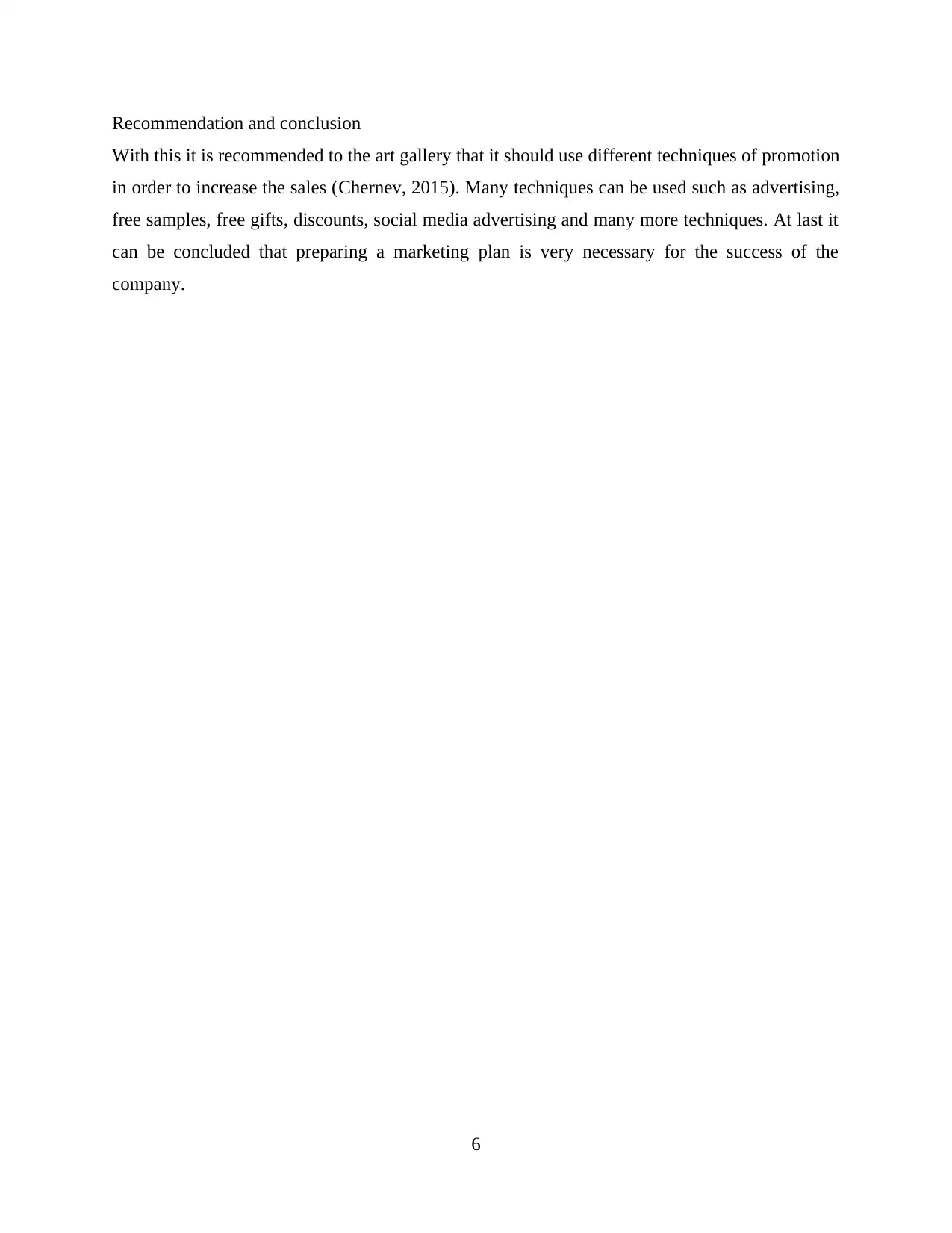
Recommendation and conclusion
With this it is recommended to the art gallery that it should use different techniques of promotion
in order to increase the sales (Chernev, 2015). Many techniques can be used such as advertising,
free samples, free gifts, discounts, social media advertising and many more techniques. At last it
can be concluded that preparing a marketing plan is very necessary for the success of the
company.
6
With this it is recommended to the art gallery that it should use different techniques of promotion
in order to increase the sales (Chernev, 2015). Many techniques can be used such as advertising,
free samples, free gifts, discounts, social media advertising and many more techniques. At last it
can be concluded that preparing a marketing plan is very necessary for the success of the
company.
6
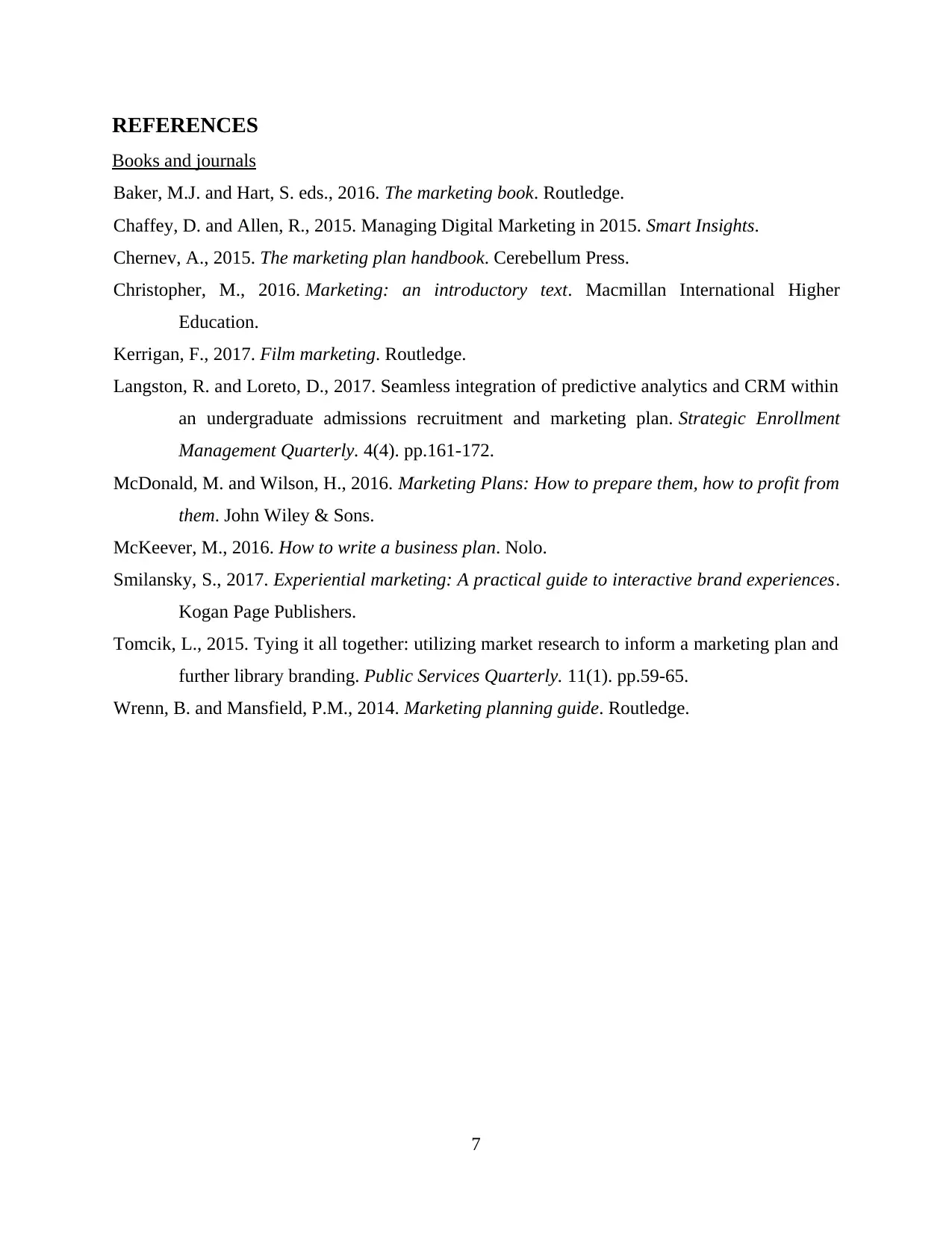
REFERENCES
Books and journals
Baker, M.J. and Hart, S. eds., 2016. The marketing book. Routledge.
Chaffey, D. and Allen, R., 2015. Managing Digital Marketing in 2015. Smart Insights.
Chernev, A., 2015. The marketing plan handbook. Cerebellum Press.
Christopher, M., 2016. Marketing: an introductory text. Macmillan International Higher
Education.
Kerrigan, F., 2017. Film marketing. Routledge.
Langston, R. and Loreto, D., 2017. Seamless integration of predictive analytics and CRM within
an undergraduate admissions recruitment and marketing plan. Strategic Enrollment
Management Quarterly. 4(4). pp.161-172.
McDonald, M. and Wilson, H., 2016. Marketing Plans: How to prepare them, how to profit from
them. John Wiley & Sons.
McKeever, M., 2016. How to write a business plan. Nolo.
Smilansky, S., 2017. Experiential marketing: A practical guide to interactive brand experiences.
Kogan Page Publishers.
Tomcik, L., 2015. Tying it all together: utilizing market research to inform a marketing plan and
further library branding. Public Services Quarterly. 11(1). pp.59-65.
Wrenn, B. and Mansfield, P.M., 2014. Marketing planning guide. Routledge.
7
Books and journals
Baker, M.J. and Hart, S. eds., 2016. The marketing book. Routledge.
Chaffey, D. and Allen, R., 2015. Managing Digital Marketing in 2015. Smart Insights.
Chernev, A., 2015. The marketing plan handbook. Cerebellum Press.
Christopher, M., 2016. Marketing: an introductory text. Macmillan International Higher
Education.
Kerrigan, F., 2017. Film marketing. Routledge.
Langston, R. and Loreto, D., 2017. Seamless integration of predictive analytics and CRM within
an undergraduate admissions recruitment and marketing plan. Strategic Enrollment
Management Quarterly. 4(4). pp.161-172.
McDonald, M. and Wilson, H., 2016. Marketing Plans: How to prepare them, how to profit from
them. John Wiley & Sons.
McKeever, M., 2016. How to write a business plan. Nolo.
Smilansky, S., 2017. Experiential marketing: A practical guide to interactive brand experiences.
Kogan Page Publishers.
Tomcik, L., 2015. Tying it all together: utilizing market research to inform a marketing plan and
further library branding. Public Services Quarterly. 11(1). pp.59-65.
Wrenn, B. and Mansfield, P.M., 2014. Marketing planning guide. Routledge.
7
1 out of 9
Related Documents
Your All-in-One AI-Powered Toolkit for Academic Success.
+13062052269
info@desklib.com
Available 24*7 on WhatsApp / Email
![[object Object]](/_next/static/media/star-bottom.7253800d.svg)
Unlock your academic potential
© 2024 | Zucol Services PVT LTD | All rights reserved.





